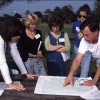Abstract
A result of the influx of new residents to the South is an expansion of urban areas into forests and other natural areas, creating areas referred to as the wildland-urban interface. Interface issues of most concern vary from state to state, but some key issues are consistent across the South. the US Forest Service conducted a series of focus groups in 2000. Key issues gleaned from those focus groups and other related sources are described in this 5-page fact sheet written by L. Annie Hermansen-Baez, Jennifer Seitz, and Martha C. Monroe, and published by the UF Department of School of Forest Resources and Conservation, February 2013.
References
Dwyer, J.F., D. J. Nowak, M. H. Noble, and S. M. Sisinni. 2000. Connecting people with ecosystems in the 21st century: An assessment of our nation's urban forests. Gen. Tech. Rep. PNW-GTR-490. Portland, OR: US Department of Agriculture, Forest Service, Pacific Northwest Research Station. 483 p. https://doi.org/10.2737/PNW-GTR-490
Frumkin, H., L. Frank, and R. Jackson. 2004. Urban sprawl and public health: Designing, planning and building for healthy communities. Washington, D.C.: Island Press. 366 p.
Graham, K. L. Human influences on forest wildlife habitat. In: The southern forest resource assessment. D. N. Wear and J.G. Greis, eds. 2002. Gen. Tech. Rep. SRS-53. Asheville, N.C.: U.S. Department of Agriculture, Forest Service, Southern Research Station: 63-90.
Hubbard, W. G. and D. A. Hoge. Managing private nonindustrial forestlands at the interface. In: Forests at the wildland-urban interface: conservation and management. S.Vince, M. L. Duryea, E. A. Macie, and L. A. Hermansen, eds. 2005. Boca Raton, FL: CRC Press: 225-68. https://doi.org/10.1201/9780203484463.ch17
Hull, R.B., R. Visser, and S. F. Ashton. Module 2: Managing interface forest. In: Changing roles: wildland-urban interface professional development program. M. C. Monroe, L.W. McDonell, and L. A. Hermansen-Báez, eds.. 2006. Gainesville, FL: University of Florida.
Hull, R. B. and S. I. Stewart. Social consequences of change. In: Human influences on forest ecosystems: The southern wildland-urban interface assessment. E. A. Macie and L. A. Hermansen, eds. 2002. Gen. Tech. Rep. SRS-55. Asheville, NC: US Department of Agriculture Forest Service, Southern Research Station: 115-29.
Monroe, M. C., A. W. Bowers, and L. A. Hermansen. 2003. The moving edge: Perspectives on the southern interface, Southern Wildland-Urban Interface Assessment Focus Group Report. Gen. Tech. Rep. SRS-63. Asheville, NC: US Department of Agriculture, Forest Service, Southern Research Station. 35 p.
U.S. Census Bureau. 2008. An older and more diverse nation by mid-century. http://www.census.gov/Press-Release/www/releases/archives/population/012496.html [Date accessed: October 9, 2008].
U.S. Census Bureau, Population Division. 2006. Table 9: Population estimates for the 100 fastest growing U.S. counties with 10,000 or more population in 2005: April 1, 2000 to July 1, 2005 (CO-EST2005-9).
Wear, D. N. 2002. Land use. In: The southern forest resource assessment. D. N. Wear and J. G. Greis, eds. Gen. Tech. Rep. SRS-53. Asheville, N.C.: U.S. Department of Agriculture, Forest Service, Southern Research Station: 153-173.
Wear, D.N. and J. G. Greis, eds. The southern forest resource assessment. Gen. Tech. Rep. SRS-53. Asheville, N.C.: U.S. Department of Agriculture, Forest Service, Southern Research Station: 153-173.
Zipperer, W. Urban Influences on forest ecosystems. In: Human influences on forest ecosystems: the southern wildland-urban interface assessment. E. A. Macie and L. A. Hermansen, eds. 2002. Gen. Tech. Rep. SRS-55. Asheville, NC: US Department of Agriculture Forest Service, Southern Research Station: 73-91.
Unless otherwise specified, articles published in the EDIS journal after January 1, 2024 are licensed under a Creative Commons Attribution-NonCommercial-NoDerivs 4.0 International (CC BY-NC-ND 4.0) license.

